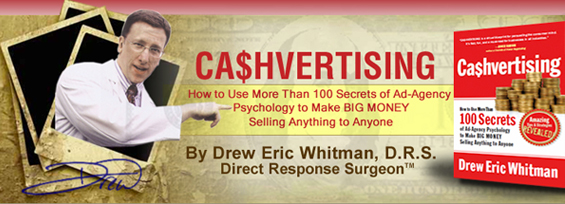How to Become a Guru (and Dominate Any Market!)
Anybody can be a Guru on the Internet. And unfortunately, nearly everybody tries.
The Internet Guru has become a caricature figure tainted by laughable self-promotion, boundless ego and really poor end product. Some of the ill-sentiment is driven by jealousy, and most of it is entirely justified.
It’s depressing for a new blogger to commit blood, sweat and tears to a project and still only reap 14 hits per day while a bumbling Super Personality typos his way to the next million.
If you are moving in to a new market and wish to establish yourself as an ‘authority’, there is an entire textbook of Guru Psychology for you to master.
I aim to shed light on some of it with this post.
There are 5 key skills that separate the biggest bloggers/authorities/personalities from those you’ve never heard of. Let’s tuck in.
1. Relate to Your Market
Imagine you are campaigning to be President of the United States. What’s the first thing you do?
Note: If your name is Mitt Romney, please stop reading. We already know the answer: “Make a complete bag of dicks out of myself.”
Your first objective should be to relate to the people whose opinions and trust you hope to gain. You seek common ground.
Every Presidential candidate in the modern age has fought to gain trust by creating an illusion that goes simply, “I’m just like you.”
How does this tie in to guru psychology? Well, let me put it this way. If you can’t convince your target market that you share the same hopes, values and dreams, they will vote for somebody else who does.
Familiarity breeds popularity. It wins votes, as well as readers, leads and sales.
There’s a very simple process that is capable of popularizing you to any market in the world.
It goes like this:
Find the hopes, dreams, fears and complaints of the audience you wish to speak for.
Create a persona that is the Superhero Conquerer of the emotions above.
i.e. Their fears, you conquer. Their hopes, you believe in. Their dreams, you realise. Their complaints, you put voice to.
Be where your audience is likely to find you.
Just three small steps.
Three steps that I have yet to see fail when executed correctly.
Here’s a suggestion for finding your brand I wrote on ProBlogger yesterday:
Those who can put in to elegant words what their peers can only feel intuitively in their heads will always inspire and captivate. If you possess this gift, use it. Let your blog become the voice of expression that readers can link to and say, “I agree with that guy.”
Every guru knows that his ship will sink or sail on the back of one question;
“Is my story empowering – or disempowering?”
I’ll give you a clue. People won’t read your shit unless it affects them. And they’ll only read it once if it affects them in the wrong way.
2. Monitor the Industry’s Engagement Rate
If you are a long time reader of this blog, you will probably have a conscious understanding of how I choose to engage with you – whether I tell you about it or not.
I post once per week. I believe firmly in “If you have nothing useful to say, STFU“. Every post I publish, I want you to read fully. If I start hitting you with infographics and irrelevant Mashable style ‘Top Tens’, you will stop listening so carefully. I know this because, like me, you have very little time in your day. And you already feel guilty how you spend it.
My posts touch on personal, professional and industry topics. Roughly 50% of the content is designed to be actionable marketing information. The other 50% is designed to portray me. Who I am, what I believe in, which ball I’m scratching.
I release a product every 3 months but will rarely tell you about it until the day of the launch. And yet, if you read some of my ‘alias’ blogs, you’ll catch me promoting products religiously weeks before they’re due.
Why? The type of shadowy bastards that read this blog do not like to be marketed to. You will notice that when I do try to seduce you to click an affiliate link, or to buy one of my products, it is nearly always a contextual nudge – blanketed by content that is designed not to ruffle your feathers. This is not by chance. It is how I have chosen to engage with you based on the type of person that I think you are.
How you engage with your audience should be based on the wants and needs of that audience. What is going to get them to listen?
Some industries naturally require a great deal of social pandering to be successful.
If I wanted to be a successful ‘Work at Home Mom’ blogger, I would no doubt spend twice as much time scratching backs, ‘liking’ cute babies, and networking on crocodile feminist forums as I would preparing informative posts. No offence to the WAHMs (maybe I’m not American enough to understand).
Similarly, if I wanted to be a successful fashion guru… well, fundamentally, I’d be shagged. I’m about as fashionable as a rat’s arse. Secondly, I’d have to learn beautiful photography and visual aesthetics.
Fashion, crafts, and foodie ‘authorities’ place a high esteem on the eye-candy appeal of their content. Words are not enough. If you try to engage an audience with the wrong kind of content (i.e essays on ‘How to Do Makeup’), it’s going to fall flat.
To become an authority in any market, you must first learn the currency of that market.
It could be video, podcasts, vivid imagery, technical writing, illustration, or what I like to call ‘bitesize content’ (think The Daily Mail, Mashable etc).
Establish how people want to receive your content.
Do they need to be spoon fed blog posts every day? Should you be tweeting in the trenches? Can you get away with a barrage of emails? Is it beneficial to give your content a ‘personal’ touch?
Hint: For a WAHM blogger, it is. For an expert in nuclear waste disposal, a personal flavour may cast you as a dangerous megalomaniac.
The best way to monitor your industry’s engagement rate is to look at trusted authorities in the space. How do they communicate? How often? What social networks and forums do they use?
Just remember, you will always find this research more revealing when you look at what the experts were doing 12-24 months ago.
How an established blogger spends his time now is likely very different to how he spent it when he was creating his initial success. Look to the past for the true success story.
3. If you’re going to be Social, don’t be a Social Asshole
Many authorities thrive from an active presence on social networks. The vacuums of Facebook, Twitter and Pinterest are great arenas to engage your audience. But you truly do need to think before you post.
What would an authority say?
Engagement is about more than barking nonsense in the hope that you’ll be heard. The dog who barks loudest all through the night is rarely the most loved. I wish a few more ‘Social Media experts’ would understand this.
Too many people treat social media as the means to a one way conversation. Perhaps the best advice I’ve heard on using social media is to set a goal for yourself: aim to help one person in your market every single day.
I don’t mean answer their questions in 140 character or less (though that is a good ice-breaker), and I don’t mean send them a link to one of your archived blog posts. Instead, you should go above and beyond the call of duty to help them – without asking or expecting anything in return. This might involve emailing a detailed reply, or posting a long piece on a forum. It could even involve giving away one of your prized products for free.
If you do this every day, a year from now you are likely to have 365 true fans who respect and appreciate you. That is not a following that will change the world. But if you believe in the law of reciprocation, which you should, it’s a following that will prove immensely helpful.
People remember good deeds. Better yet, as human beings we are compelled biologically to return them in spades.
You might only send Joe Bloggs a 5 minute email to answer his tweet, but when he stumbles across your product six months from now, the chances of him responding to your sales plea are significantly enhanced. Subconsciously, he owes you. Never underestimate how powerful that tug can be.
To quote a man who knows all about Influence:
“People say “Yes!” to those that they owe.”
– Robert Cialdini
How many people have you helped today?
Too many ‘experts’ think the equation is ‘all about me’. “Here’s my press release, here’s my blog post, here’s my favourite article from this morning!”
When you nurture a huge following, your personal taste is more likely to crossover and influence the public domain. But until you’re Tony Robbins? Planting a thousand good deeds is far more likely to create goodwill than retweeting your own articles.
4. Search for your Platform of Knowledge
You don’t have to know everything to be a guru on the web. You can get away with knowing marginally more than 95% of your readers.
The Internet Marketing space is notorious for blogs and forums that claim to offer the secret sauce to success. Most of the owners are no closer to success than the puppets they hope to seduce. It’s a circle jerk, and it works.
Do you know why it works?
There’s an unfortunate law, shat on by many, that dictates that the guy who has spent 6 months failing knows more about his industry than the guy who entered it today. He doesn’t need to have the blueprints of success. He simply needs to have encountered some anecdotal evidence of it along his merry way.
I call this the Platform of Knowledge.
You can be an authority figure without being famous, without having a degree, without practicing what you preach, and without being what your audience aspires to be. All you need is a Platform of Knowledge. An understanding of your field that is better than the average reader.
If you have this platform, you can speak for the common hopes, dreams, fears and concerns of your audience. In many ways, the ability to relate to these emotions is much more powerful than the innate ability to solve them.
So how do you acquire a Platform of Knowledge?
It falls back to understanding your audience, and what knowledge they are most likely to benefit from.
I would advise any aspiring marketing bloggers to indulge in books from the Direct Response greats, then to get a grip on psychology, influence, and the emerging field of behavioural economics. These are topics I drown myself in daily. Not only does it help my marketing campaigns, but it allows me to talk about issues that would pass over the average affiliate blogger’s head.
Whatever market you plan to enter, there will be low hanging fruits of knowledge at your fingertips. Your job is to push yourself to consume them. Surround yourself in a wide range of literature, subscribe to challenging blogs, devour industry journals that inspire you to think independently.
I can guarantee that being dedicated to your field will ensure you have a distinct competitive advantage over the authority figure who decides to ‘wing it’.
Do you see what I’m saying here? To become a guru, you should… stop being a lazy bastard. Try learning more.
It’s groundbreaking advice, isn’t it? Precisely what you were not looking for.
5. Make Split Second Judgments Favourable
When somebody lands on your site, how long do you think it takes them to judge you?
The most common answer I hear is “a couple of seconds“.
You wish.
Research suggests your first impressions of a website are formed in 50 milliseconds (1/20th of a second), and subsequently shaped by the Halo effect.
The Halo effect is a cognitive bias where we associate that if somebody is skilled at A, they will also be skilled at B and C. A positive first impression – let’s say an initial aura of authority – is likely to shape the user’s thoughts for good.
In the fraction of a second that it takes for a user to judge your website, what opinion are you encouraging?
If you want to personify authority, look no further than the example set by ‘Dr. Direct’, Drew Eric Whitman. Go to his website and you will find this banner:

Author of Ca$hvertising, a book that should be in your collection.
Already, your brain has interpreted a number of visual cues and condensed them in to a cohesive stereotype.
You noted the symbolic doctor’s coat (an advertising prop that is outlawed, such is its potency). It triggered a split-second assumption that the author is powerful, responsible and qualified.
You saw the hand-scrawled signature and associated it with noteworthiness.
You saw the book, which confirmed your bias and validated his credibility.
You subconsciously interpreted the dollar bill in the background, as well as the $ in the book title. Your mind is primed to think about money.
You processed words like Surgeon and D.R.S to feel somehow inferior to the author.
Before you even know it, you have been conditioned to see Dr. Direct as an authority. Once that opinion has been shaped, it is almost unshakeable. You will search for confirmation and you will find it.
Now look at your own website.
Where can you insert authority signals and social proofing?
Here are some mental shortcuts to consider:
Ensure any personal photos are aligned with your brand. Putting on a doctor’s coat without the qualifications is, as far as I’m aware, illegal. The best alternative that I’ve found is the traditional library bookcase. It projects authority very well.
If you have been featured in noteworthy magazines, shows or blogs, crowbar them in to an “As Seen On…” section. If you haven’t been featured, get featured. Join Haro.
Use your Twitter following, RSS subscribers and Facebook ‘Likes’ to validate that other people are already your fans. Only do this if you have more than 3 fans.
Use your degree initials after your name (if you have one)
If you win any kind of award – or even get nominated for one – steal the badge and make it a prominent part of your layout.
Ask readers to vouch for your character and expertise in the form of a testimonial. I did this just last week with my Premium Posts and it is already producing more sales.
And on a final unrelated note, for God’s sake, make your website easy to read. Never use white text on a dark background.
The Transformation Starts Now — in Your Head
Aspiring to iconic ‘Guru’ status is a recurring theme for new Internet Marketers. People are beginning to recognise that fortune – in 2012 – favours those who get behind their content and put a face on it.
If you want to gain traction in a market, a pile of 500 word articles will no longer suffice.
The reality of the changing web is cause for optimism: Google can’t save you now.
Well, Halle-bloody-lujah. Have we not waited for this day?
To enter and dominate a vertical, you are going to need to do what was unthinkable in the past. And that is deal with people. Not systems, not search engine algorithms, not shitty rewritten content.
It’s time to lose the ‘cutting corners’ mindset. The transformation has to start in your head.
If you want to become an authority, start acting like one. You don’t need to be the best. Simply better than most will do.
Recommended This Week
This site is up for a King of the Bloggers Award. Whatever that is. I’m flattered to be nominated. If you want to vote, go here and choose your favourite.
Be sure to check out Adsimilis, the official sponsor of Premium Posts Volume 5 & 6. Adsimilis is one of the most effective networks in the world for CPA affiliates. Lots of offers, lots of high payouts, lots of exclusives. Sign up now.







@Alex - The current bestseller - Thinking, Fast and Slow - is a great place to start.